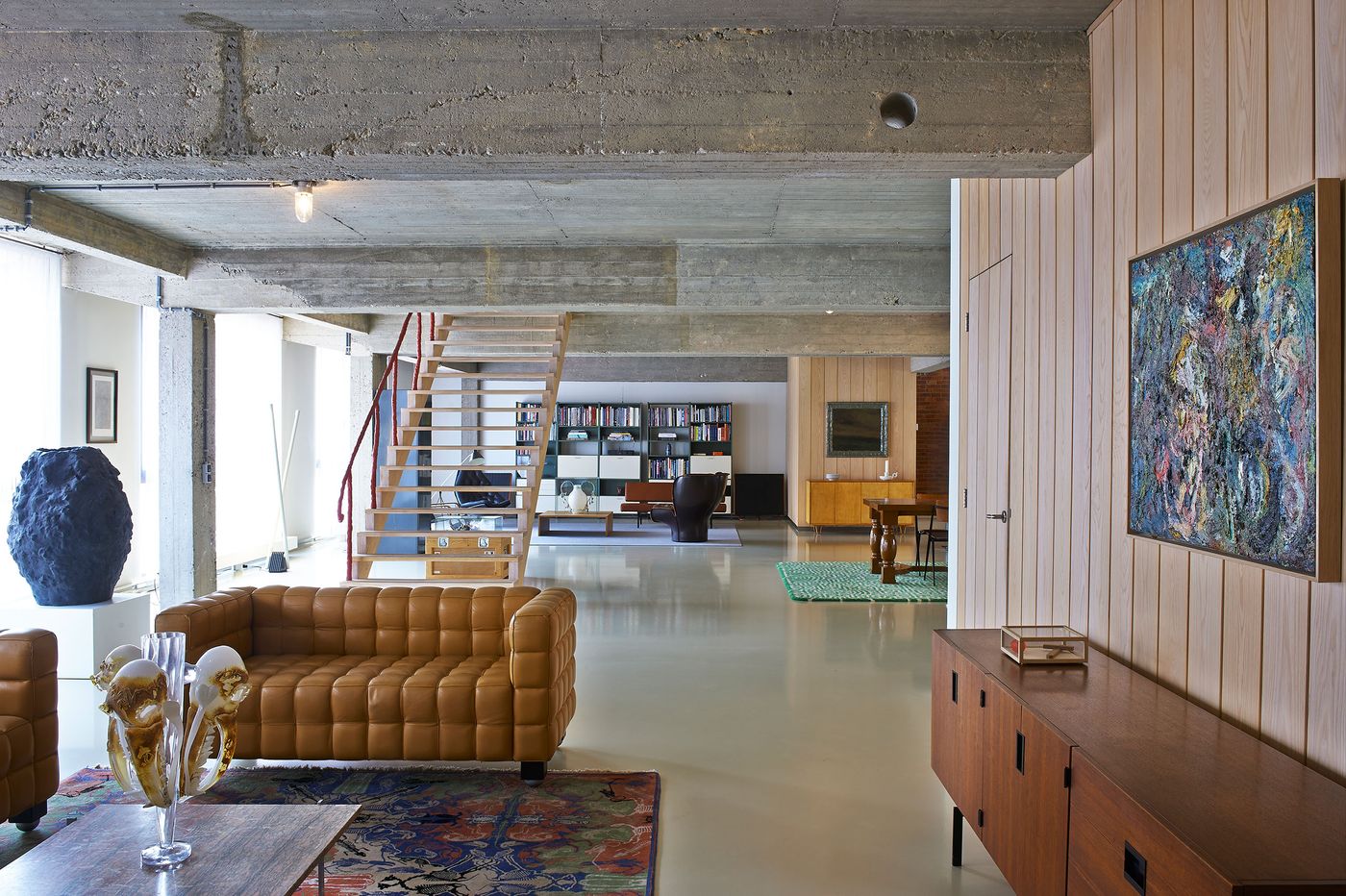
An Objective Canvas: the Idiosyncratic Loft of Studio Job in Antwerp
Words by Eric David
Location
Antwerp, Belgium
An Objective Canvas: the Idiosyncratic Loft of Studio Job in Antwerp
Words by Eric David
Antwerp, Belgium
Antwerp, Belgium
Location
Housed in a clinically renovated warehouse from the 50s, Job Smeets’ Antwerp working and living quarters contains a uniquely eclectic art and design collection, assembled throughout his years together with Nynke Tynagel, his partner behind Studio Job, the applied arts atelier known for its rich ornamentation and exquisite materials. Despite, or because of, the Studio’s extravagant aesthetic, the loft was conceived as a bare-bones bunker, “an objective canvas with pure materials” in Smeets’ words.

Roof. Chandelier Aluminium casted Chandelier, Studio Job, 2012. Relax Chair: MAL 1956, Bob Copray & Niels Wildenberg, 2011. Photo by Dennis Brandsma.
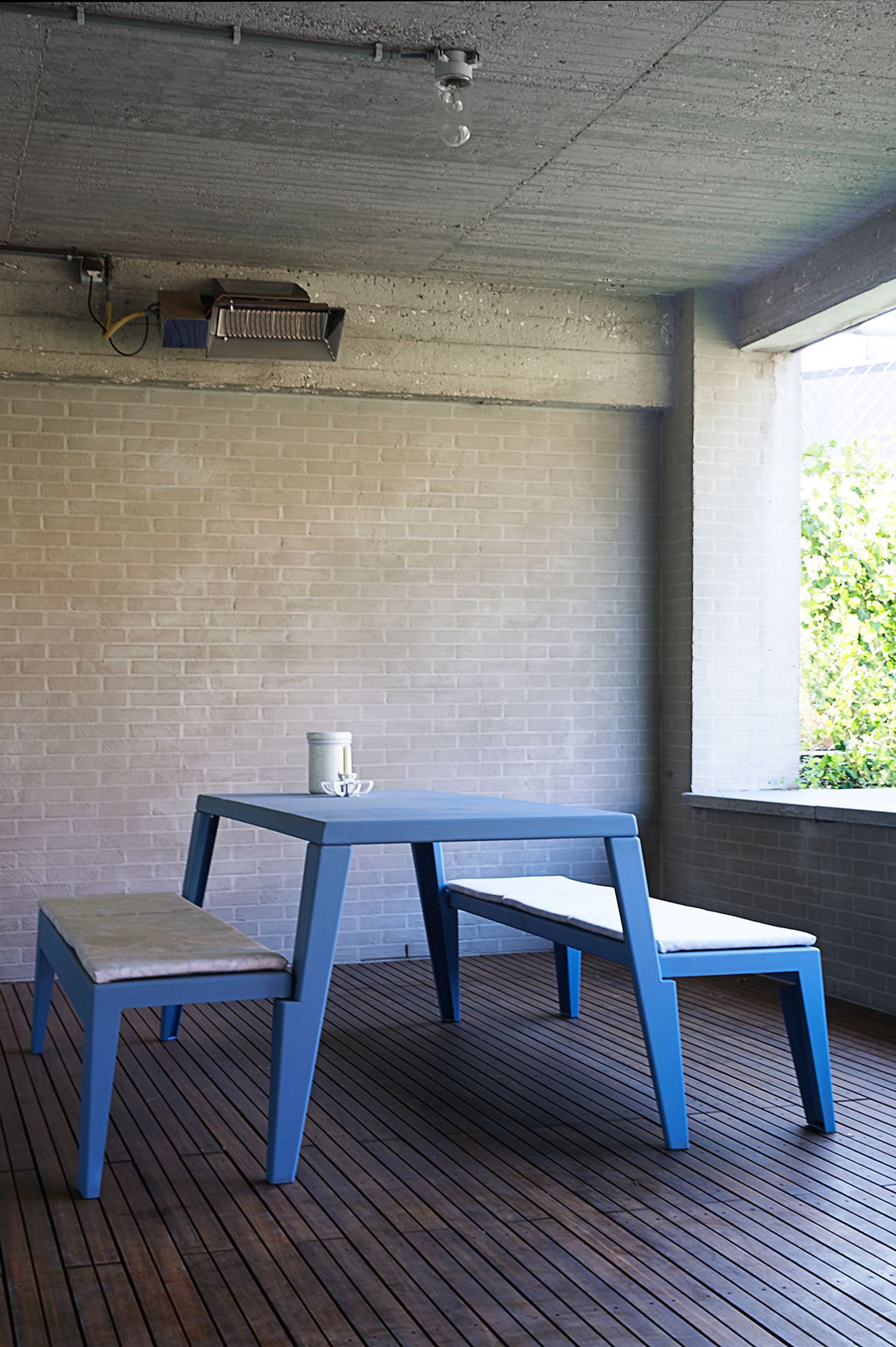
Terrace next to kitchen. Outdoor table Etcetera, Bram Boo for FELD, upholstered with Firmship Fabric by Studio Job. Silhouette Sconce, Studio Job, 2005. Pot, Royal Tichelaar Makkum, Studio Job, 2009. Photo by Dennis Brandsma.
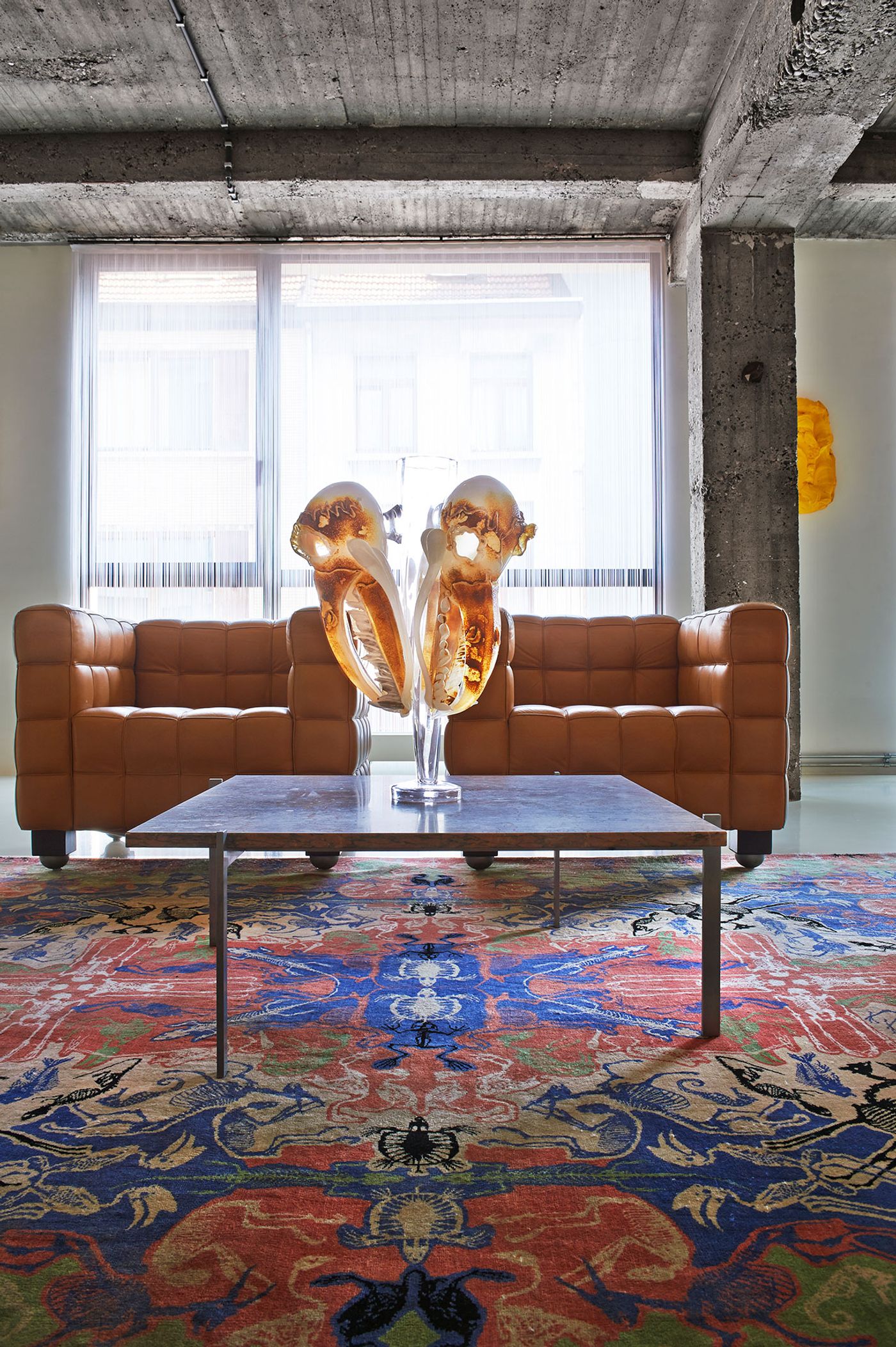
Living room. Carpet: Perished, Studio Job for Nodus, 2010. Coffee table: PK 61 Poul Kjaerholm, 1956. Vase: Boris Sipek, 2000. Bank: Cube, Joseph Hoffmann, 1910. Bronze: Diamond, Studio Job, 2002.
Painting: Yellow, Bram Bogart, 2007. Photo by Dennis Brandsma.
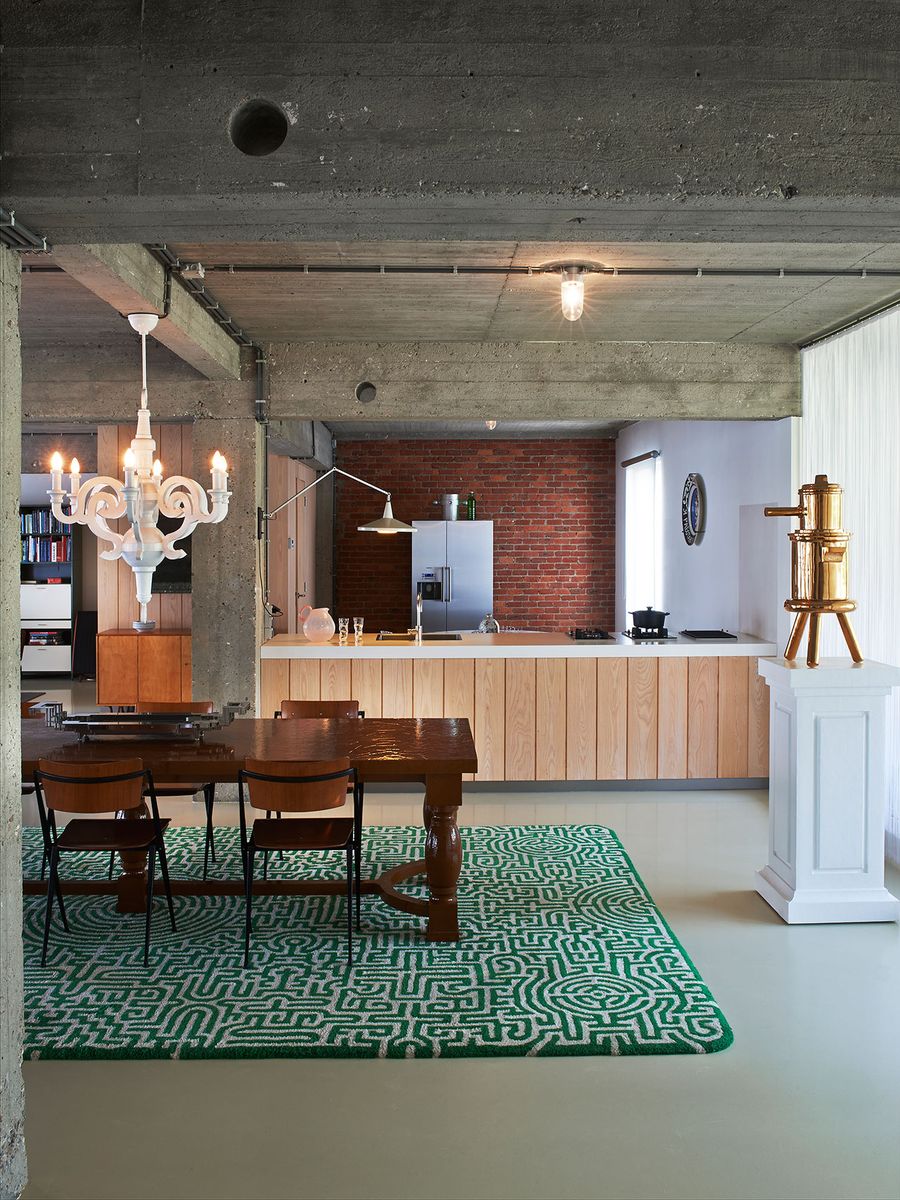
Wall lamp: Panama, Gispen, Wim Rietveld, 1955. Ceramic plate: Aeroflot, Ravage, 1990. Chandelier: Paper Chandelier (special), Moooi, Studio Job, 2005. Bronze: Homework, Pinnochio, Studio Job, 2007. Table: paper dining Table, Studio Job, 2007. Chairs: Pyramid chairs, Ahrend, Wim Rietveld, 1960. Scale: no screw no glue, Joost van Bleiswijk, 2008. Carpet: Labyrinth, Textile Museum, Studio Job, 2006. Photo by Dennis Brandsma.
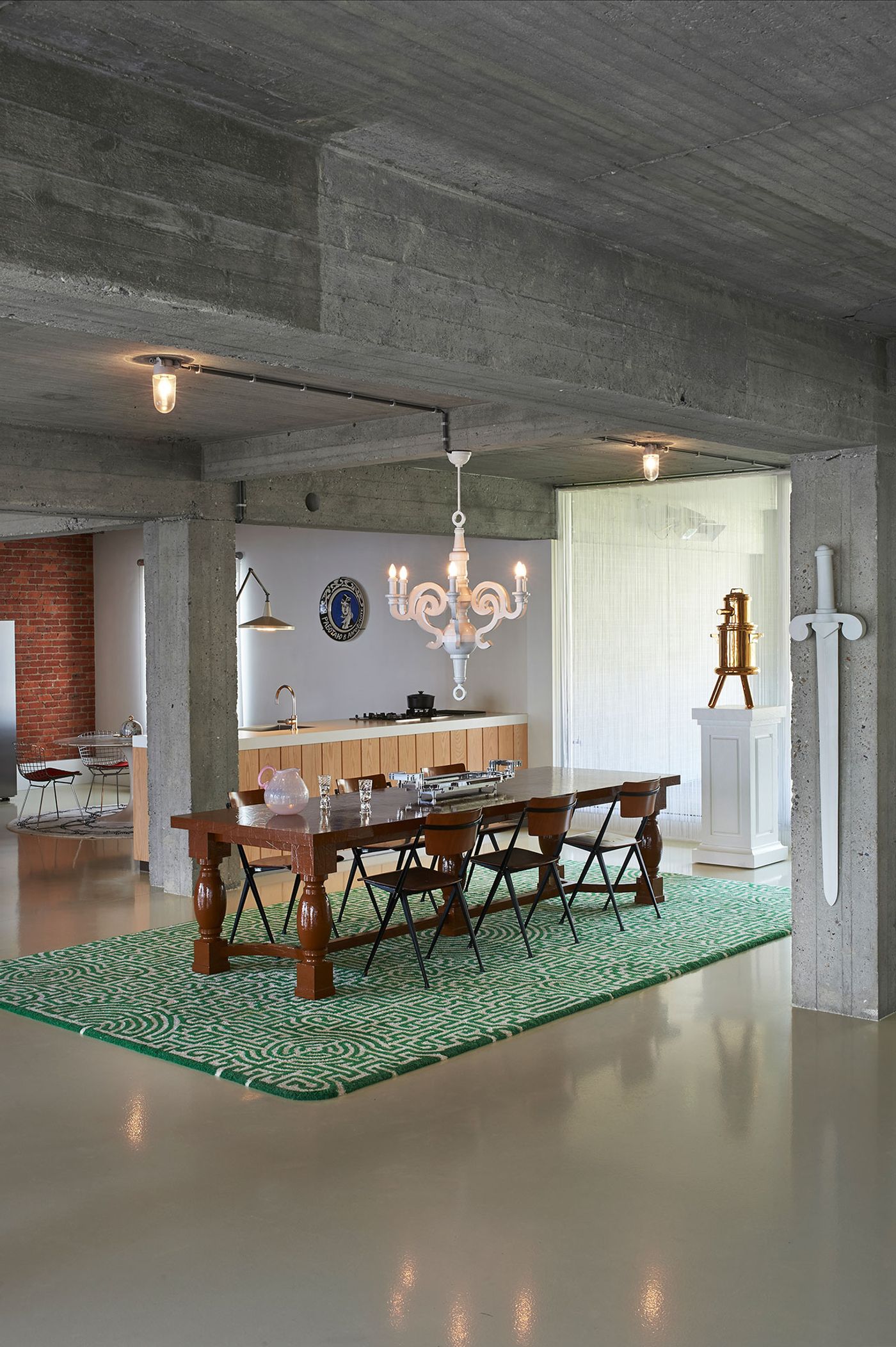
Dining room.
Roundtable: Knoll Eero Saarinen, 1953. Wire chairs: Knoll, Harry Bertoia, 1950-1952
Wall lamp: Panama, Gispen, Wim Rietveld, 1955. Ceramic plate: Aeroflot, Ravage, 1990. Chandelier: Paper Chandelier (special), Moooi, Studio Job, 2005. Bronze: Homework, Pinnochio, Studio Job, 2007. Porcelain sword: Sword, Studio Job, 2003. Table: paper dining Table, Studio Job, 2007. Chairs: Pyramid chairs, Ahrend, Wim Rietveld, 1960. Pink can: TE, Grand Bernard, Scholten & Baijings, 2009. Scale: no screw no glue, Joost van Bleiswijk, 2008. Carpet: Labyrinth, Textile Museum, Studio Job, 2006. Photo by Dennis Brandsma.
Located in a neighborhood of architects, artists and designers in the middle of the diamond district in central Antwerp —quite appropriate considering Studio Job’s artisanal work philosophy—the warehouse, which at one point also housed a school for the Orthodox-Jewish community, was chosen for its simplicity in form and its sturdy, concrete foundations, an advantage in a city full of canals. The building, completely renovated in 2008, was stripped down to its bare structure and opened up to create a single open space of 700 square meters spread across two floors. The no-frills approach to the interiors—exposed concrete, casted floors and raw wooden elements— which involved “no design” as Smeets poignantly explains, not only retains the authentic character of the building but also creates a neutral background to house the eclectically selected art and furniture. The only major intervention to be found are the stairs linking the communal areas on the lower floor with the bedroom above, a light-weight wooden structure with a sculptural, red handrail by Dutch designer Maarten Baas.
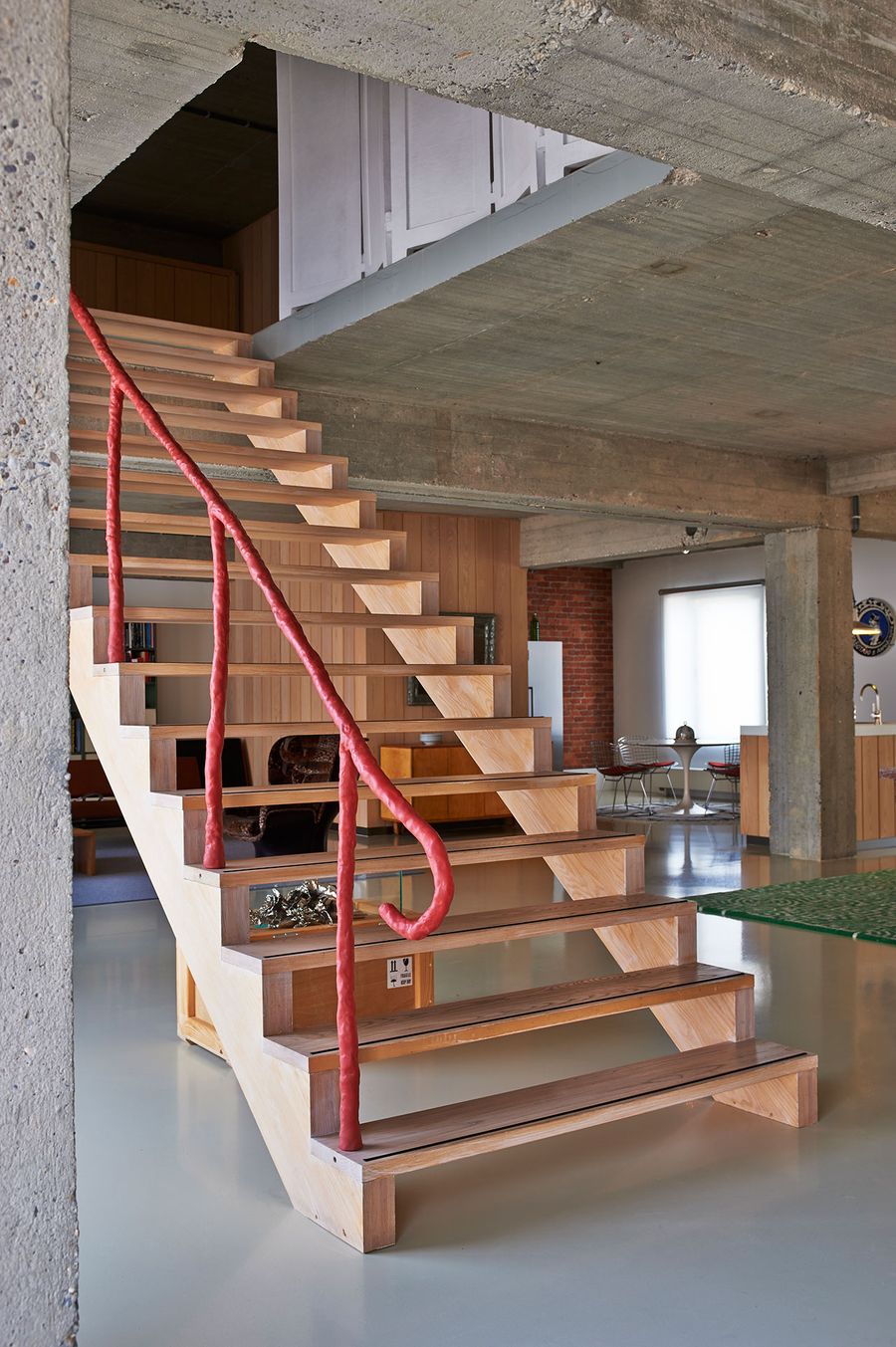
Stairway. Handrail: Clay, Maarten Baas, 2010. Roundtable: Knoll Eero Saarinen, 1953. Dome: Dome, Last Supper, Studio Job, 2009. Photo by Dennis Brandsma.
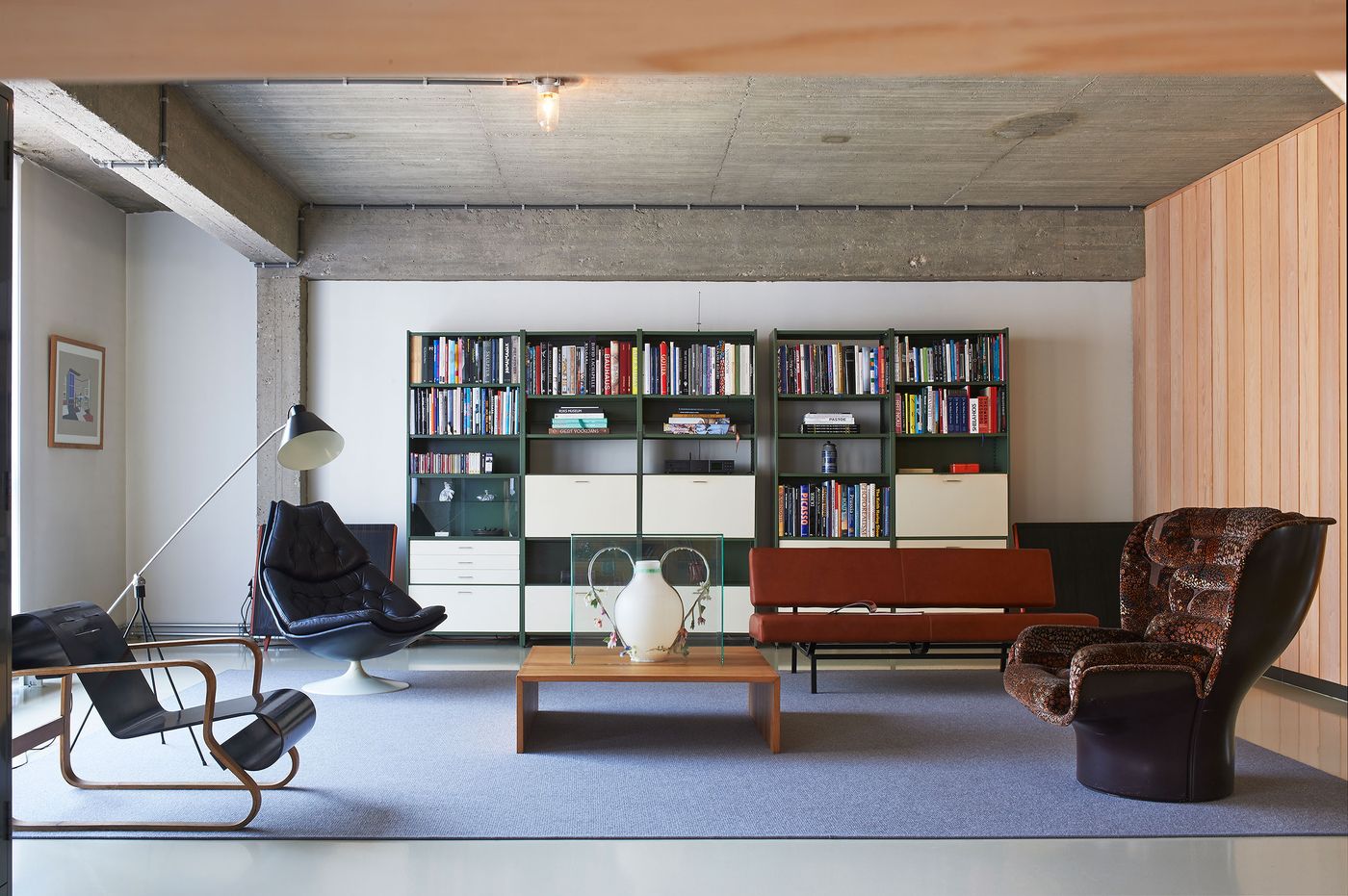
Living Room (next to kitchen). Sofa Elda De Joe Colombo. Big Frozen Vase, Wieki Somers. Paimio Chair, Alvar Aalto. Magneto Lamp, H. Fillekes for Artifort. Sofa, Martin Visser For Spectrum. Shelve Cabinet, André Cordemeyer For Gispen. Photo by Dennis Brandsma.
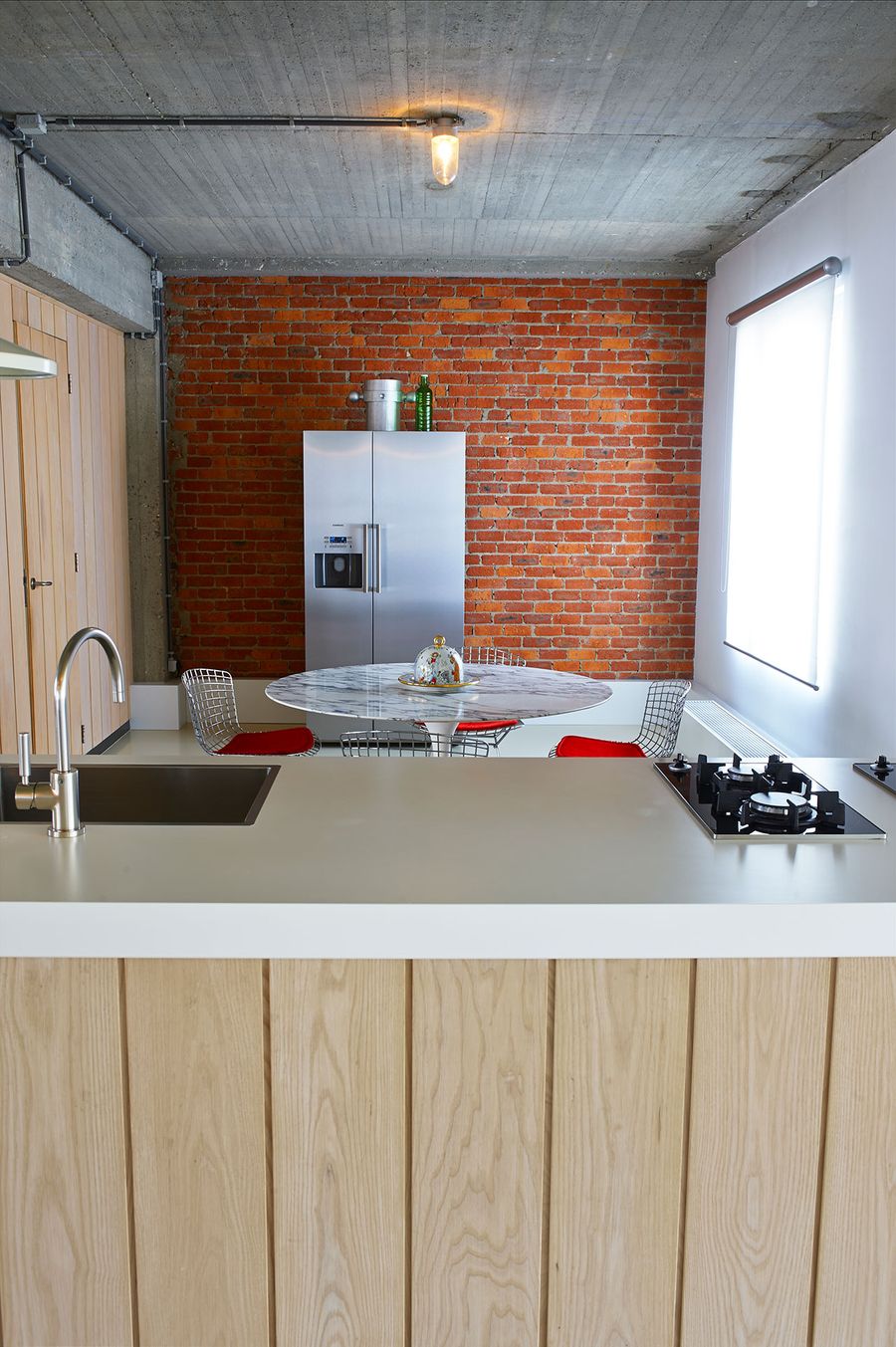
Kitchen. Tulip Table, Eero Saarinen for Knol. Wire Chair, Harry Bertoia for Knoll. Dome on Plate from The Last Supper, Royal Tichelaar Makkum by Studio Job. Paper Wine Cooler, Studio Job. Photo by Dennis Brandsma.
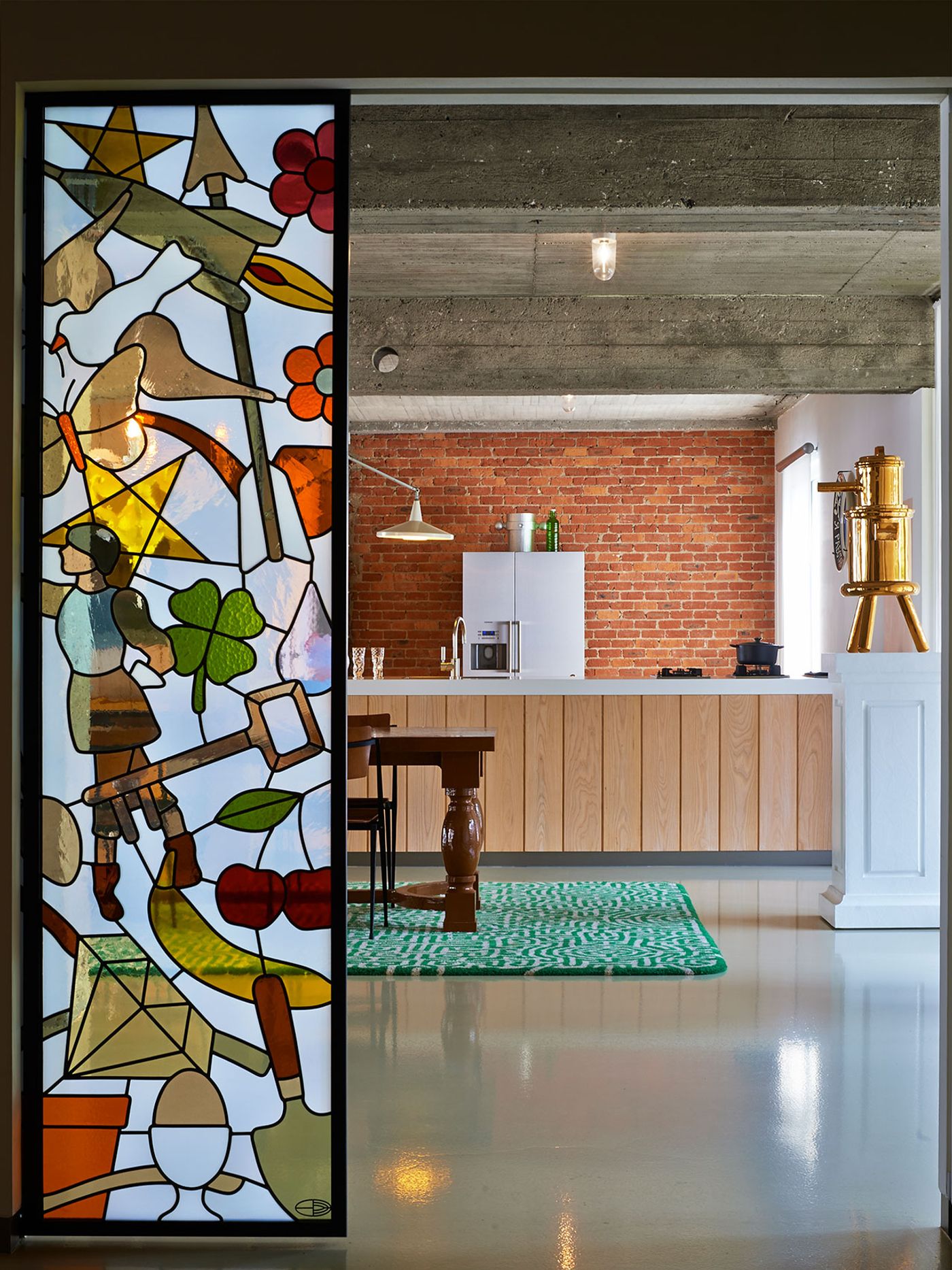
Corridor and eetvertrek. Cooler: Paper & Glass, Studio Job, 2002. Wall lamp: Panama, Gispen, Wim Rietveld, 1955.
Bronze: Homework, Pinnochio, Studio Job, 2007. Carpet: Labyrinth, Textile Museum, Studio Job, 2006. Table: paper dining Table, Studio Job, 2007. Chairs: Pyramid chairs, Ahrend, Wim Rietveld, 1960. Stained glass sliding door: Princes & fool, Studio Job, 2007. Photo by Dennis Brandsma.
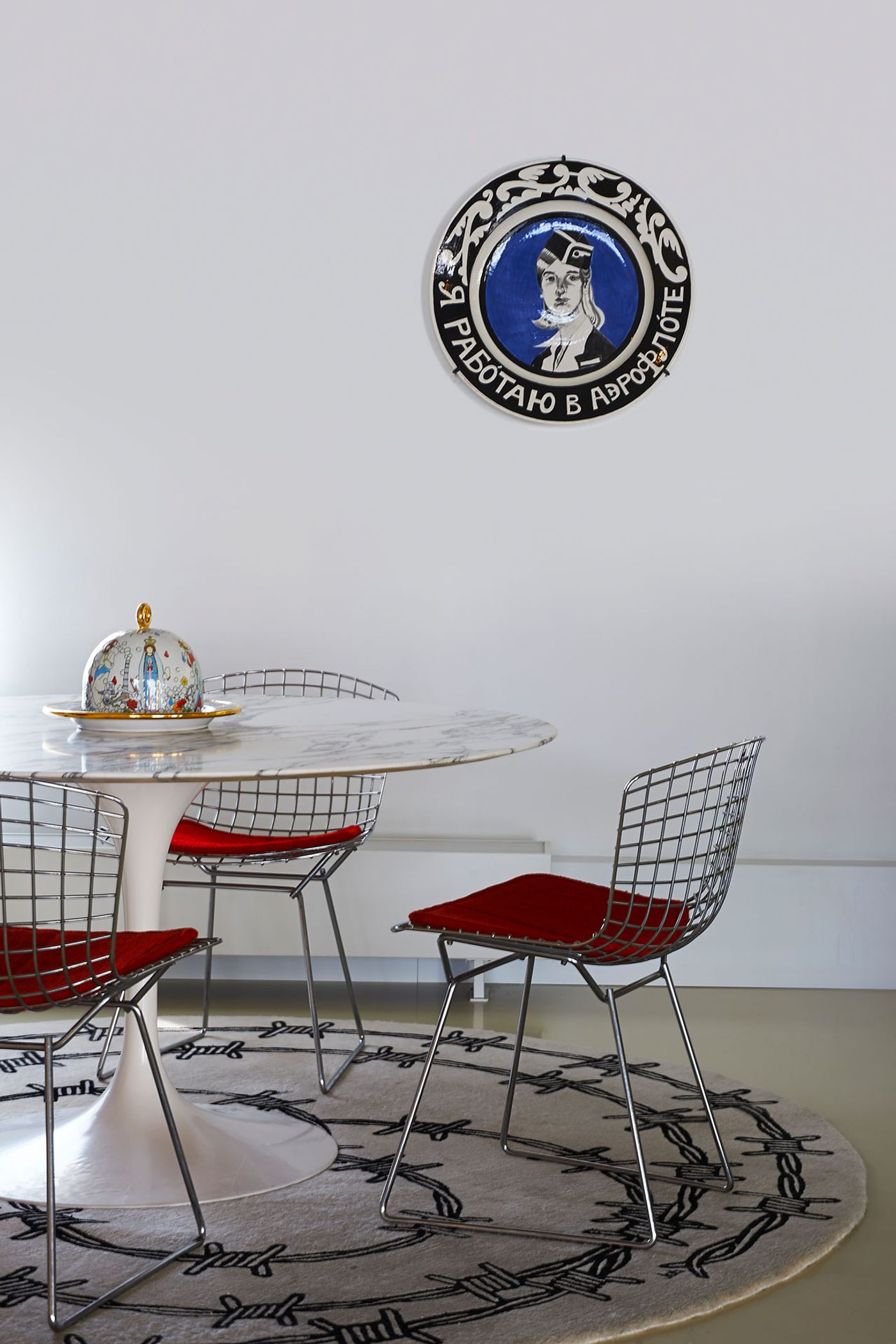
Kitchen. Tulip Table, Eero Saarinen for Knoll. Wire Chair, Harry Bertoia for Knoll. Dome on Plate from The Last Supper, Royal Tichelaar Makkum by Studio Job. Barb Wire, Studio Job for Nodus. Plate, Ravage. Photo by Dennis Brandsma.
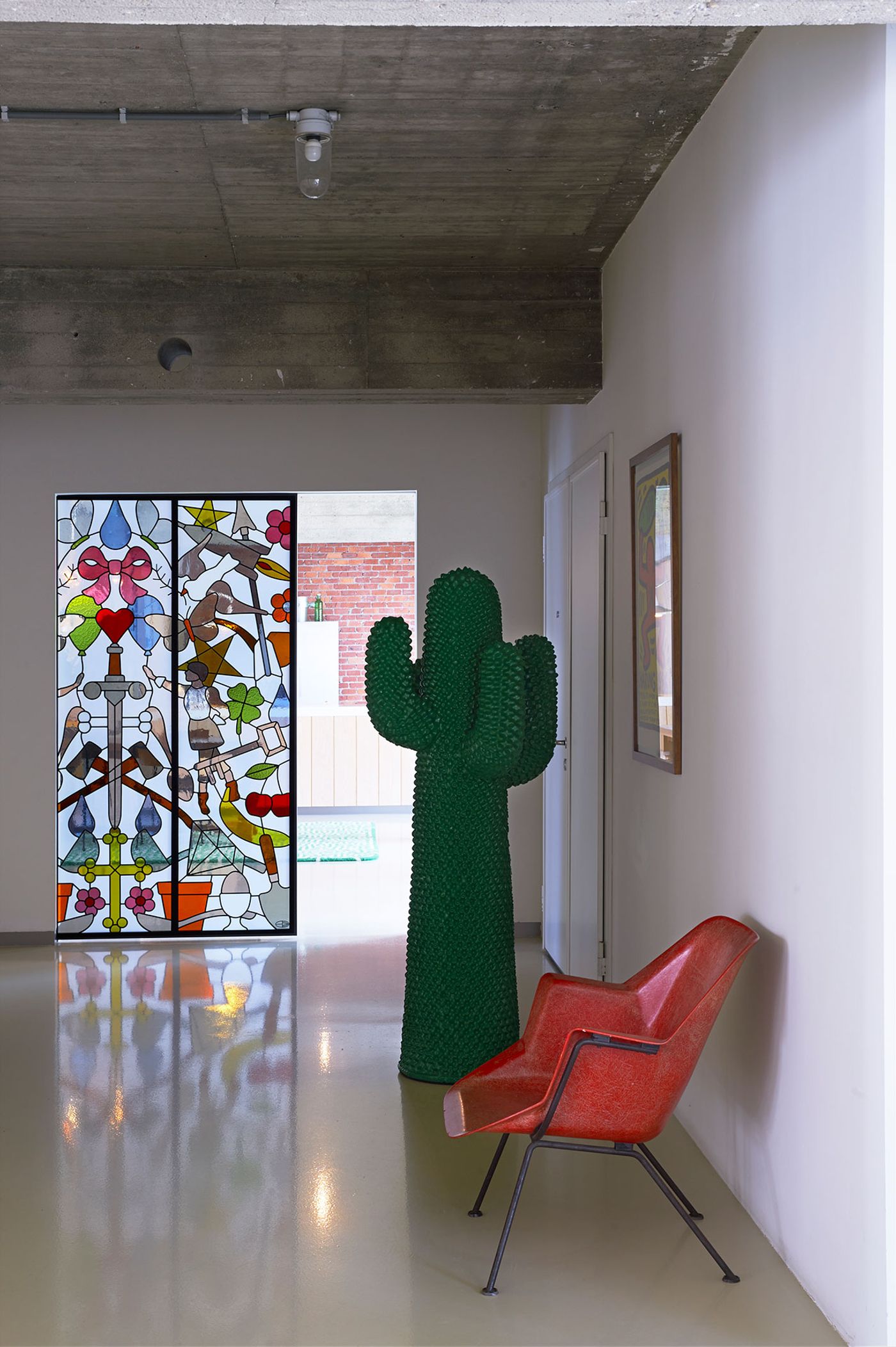
Hall. Stained Glass Sliding Doors, Studio Job. Cactus, Gufram. Chair, Wim Rietveld. Poster, Keith Haring. Photo by Dennis Brandsma.

Studio. Chair: Aeron, Herman Miller. Desk: T96, Techno, Osvaldo Borsani, 1955. Carpet: Quack, Nodus, Studio Job, 2011. Desk lamp: Work, Tichelaar Makkum, the Dick Hoff, 2007. Pouf: Playtime, Montis, Studio Job, 2005. Mirror: DZ84, 't Spectrum, Benno, 1956. Lamp Candle Stick, Mae West, Venini, Studio Job, 2011. Cabinet: 663 Gispen, Wim Rietveld, 1954. Mice: Johan Peter Hol, 2003. Vase: mat, Cor Unum, Benno, 1993. Champagne Piper Heidsieck, Viktor & Rolf, 2007. Bucket seat: Gispen 416, Wim Rietveld & Andre Cordemeyer, 1955. Oak plank: smoke, Maarten Baas, 2007. Poster: Centraal Museum, Anthon Beeke, 1984. Photo by Dennis Brandsma.
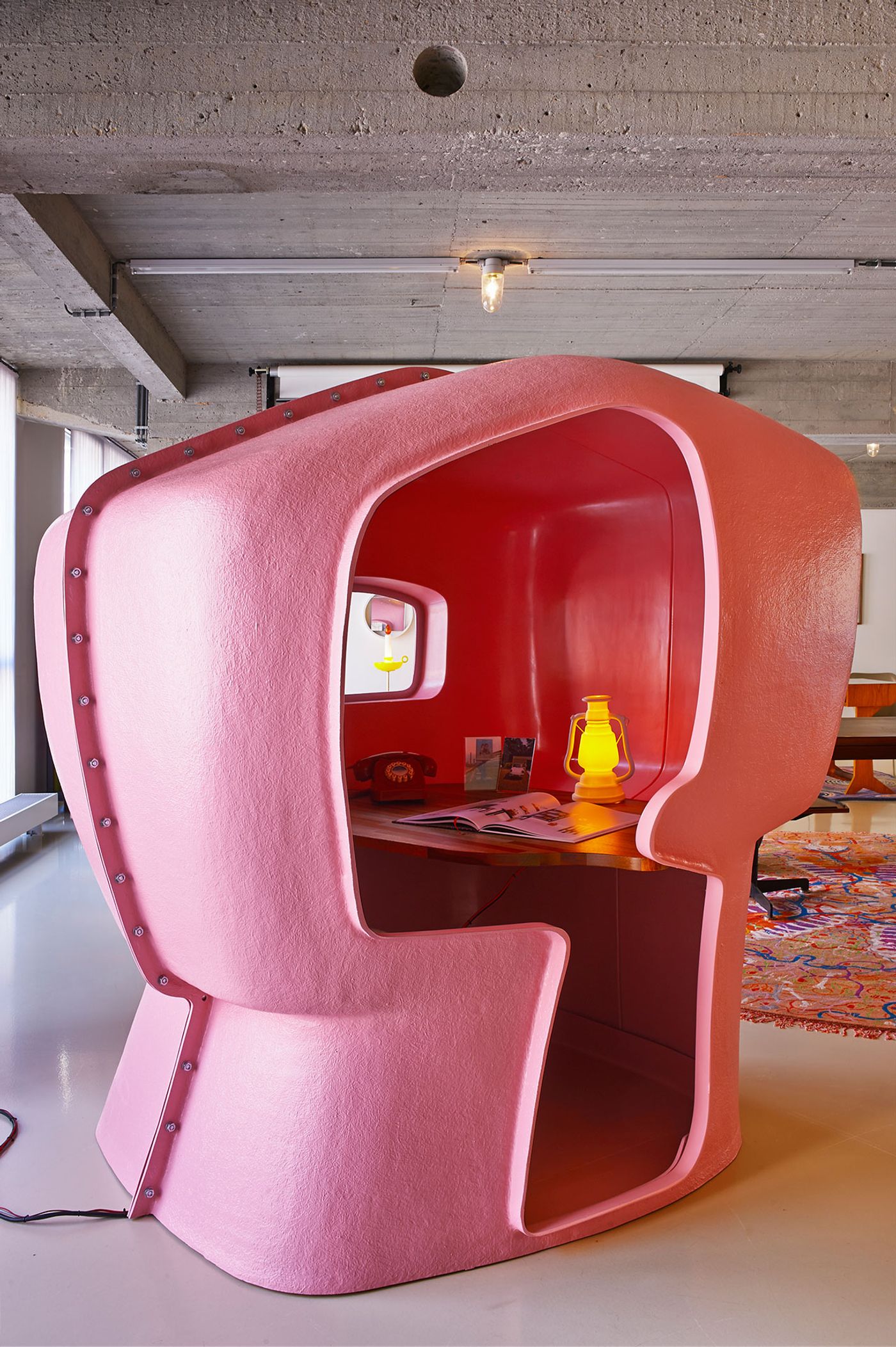
Studio. Cell: work skull, Atelier van Lieshout, 2005. Lantern: porcelain bought in Maastricht 2012. Phone: phone bought in Paris, 2011. Photo by Dennis Brandsma.
As expected, several of Studio Job’s designs are also present throughout, from functional elements like the “Paper Chandelier” manufactured by Moooi, “Quack”, a hand-knotted round carpet produced by Nodus and “Chaise Longue”, a modular armchair, to more decorative works like “Perished”, a rosewood, maple and brass bed-headboard, veneered in a complex pattern of skeletons of extinct animals, and “Homework: Pinocchio”, a totemic cast-bronze sculpture on a wedge wood pedestal. The only item specially designed for the loft is the colorful, stained glass sliding door separating the kitchen from the rest of the living area, which depicts Smeets, Tynagel and The Sword—a heraldic motif that recurs in Studio Job’ work.
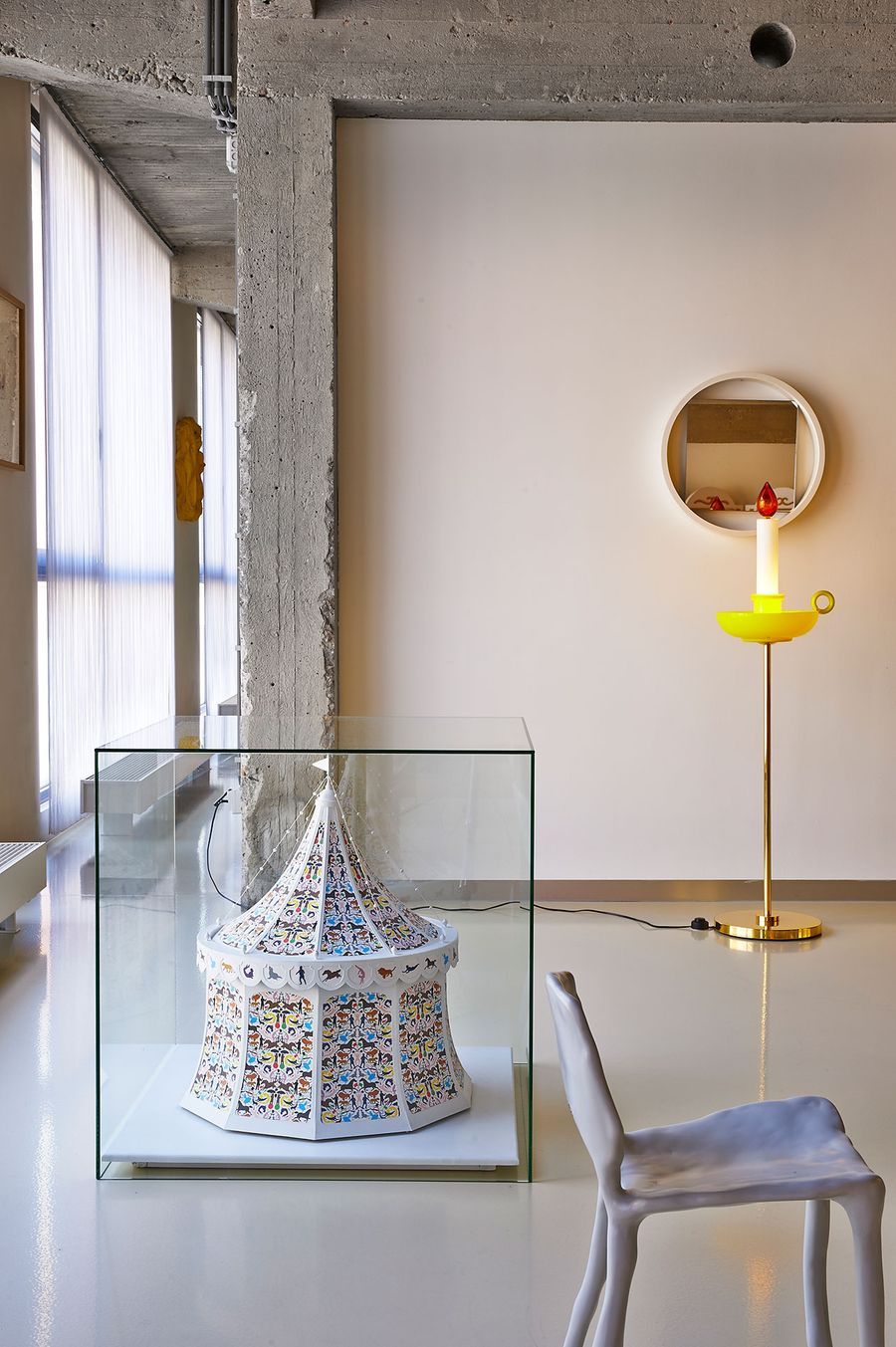
Office. Circus, Studio Job. Sconce, Studio Job for Venini. Mirror, Benno Premsela. Children’s Clay Chair, Maarten Baas. Photo by Dennis Brandsma.
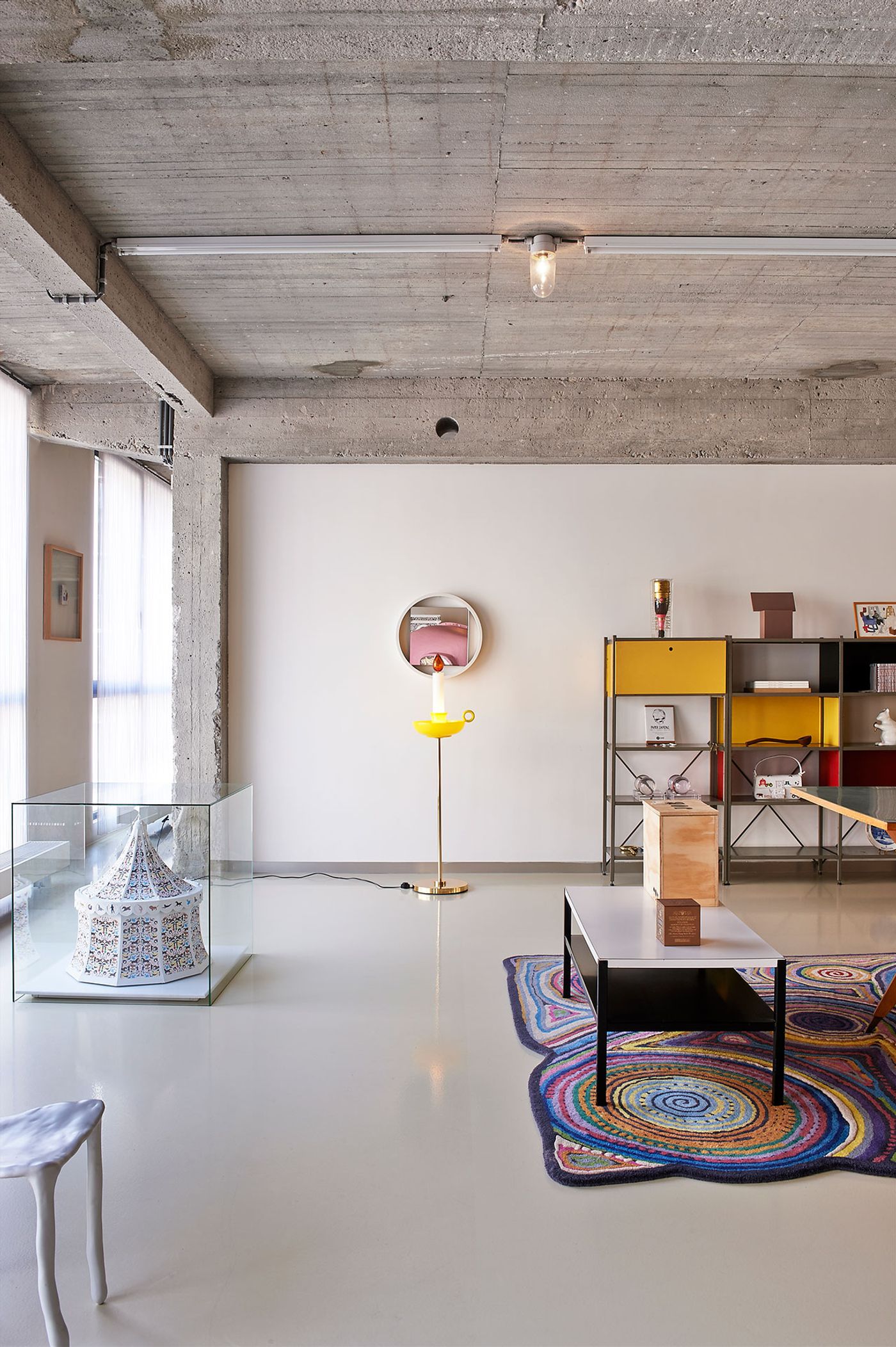
Office. Circus, Studio Job. Sconce, Studio Job for Venini. Mirror, Benno Premsela. Sushi, Campana Brothers for Nodus. Children’s Clay Chair, Maarten Baas. Shelves, Wim Rietveld and André Cordemeyer for Gispen. Photo by Dennis Brandsma.

Studio. Desk & secretary: Ico Parisi, 50 years. Circus: Model circus tent, Studio Job, 2005. Tile: Bart van der Leck, 1936. Carpet: Shushi, Campana Brothers, 2011. Cabinet: 663 Gispen, Wim Rietveld, 1954. Bucket seat: Gispen 416, Wim Rietveld & Andre Cordemeyer, 1955. Pouf: Playtime, Montis, Studio Job, 2005. Desk lamp: Work, Tichelaar Makkum, the Dick Hoff, 2007. Photo by Dennis Brandsma.
Rounding up this idiosyncratic abode is the roof garden, one of the biggest in Antwerp, which similarly to the interiors eschews elaborate landscaping—the designers admit they are not fond of gardening— for a simple layout, providing, as Smeets describes it, an outdoors space that “gives air and a place to hang”. Another reminder that Studio Job's loft, more than being a contemporary treasure chamber, is above all a place to live and work.
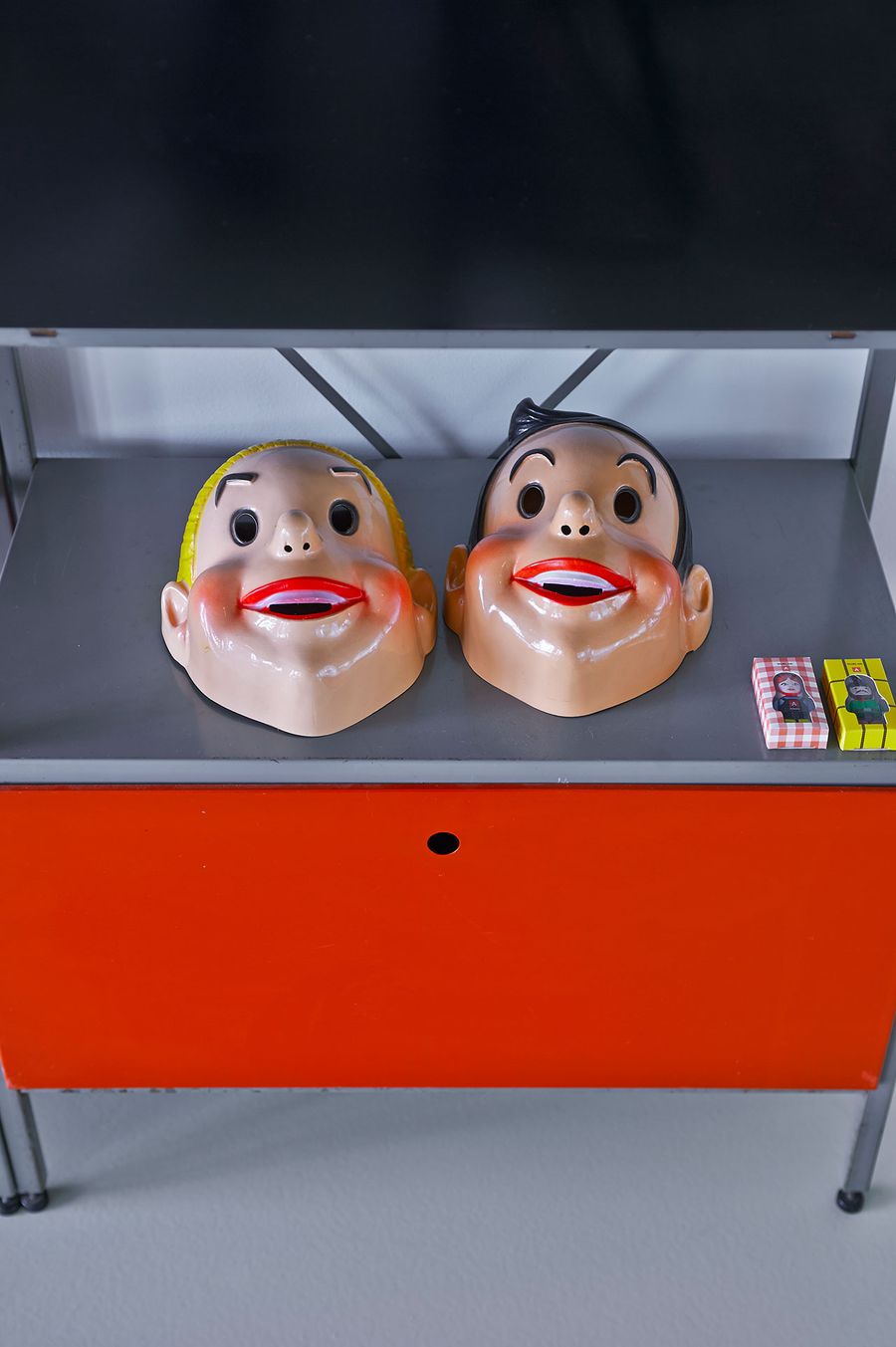
Studio. Cabinet: 663 Gispen, Wim Rietveld, 1954. Masks, Suske & Wiske, 60 years. USB Sticks: Farm, Nynke & Job, 2010.
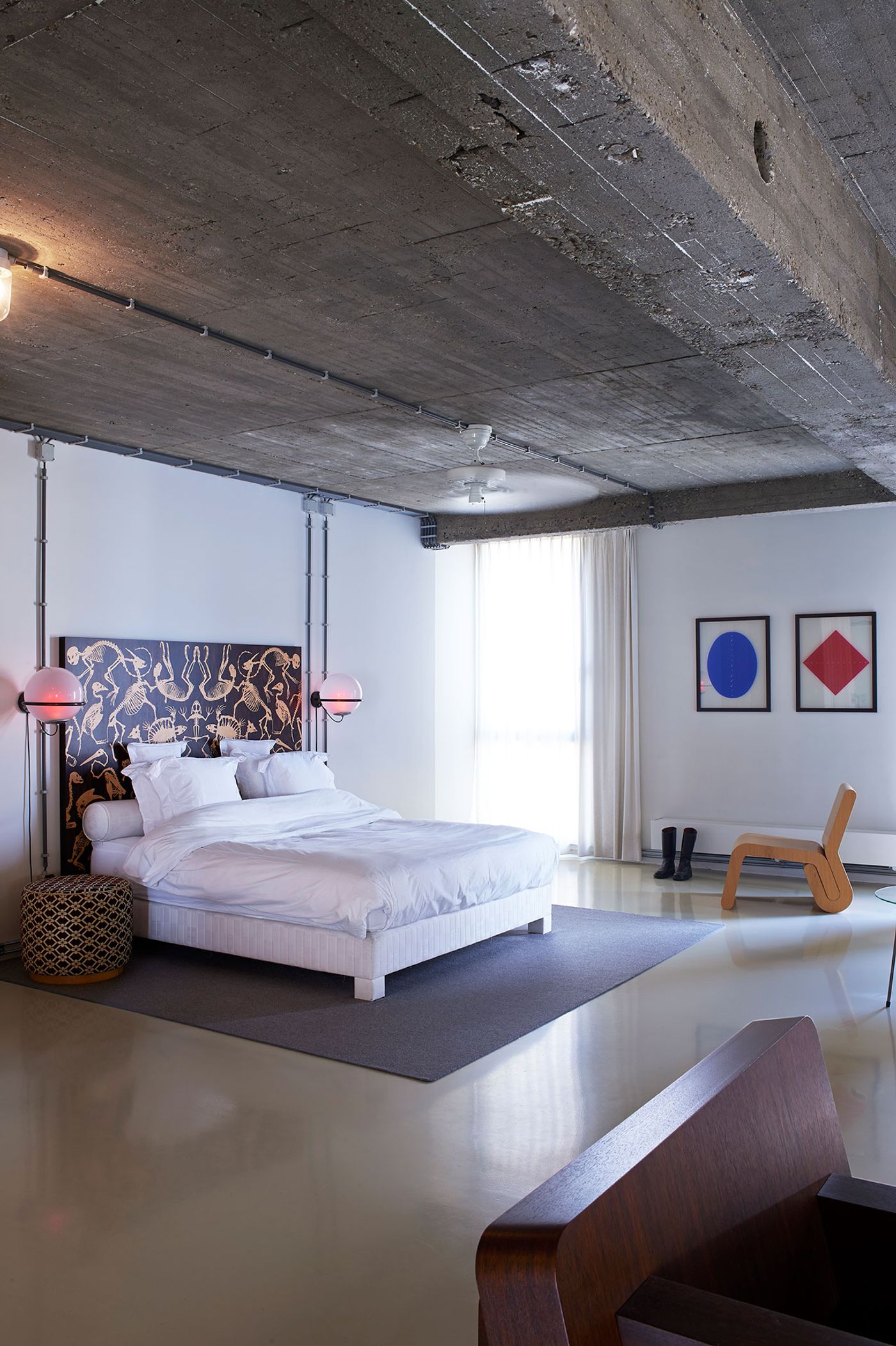
Bedroom. Bed Treca De Paris with Perished Headstand by Studio Job. Night Stand, Edward Van Vliet. Lamps 237, Gino Sarfatti for Arteluce. Curved Sofa, Studio Job. Modular Sofa, Studio Job. Graphic artwork, Concetto Spatiazale, Lucio Fontana. Photo by Dennis Brandsma.
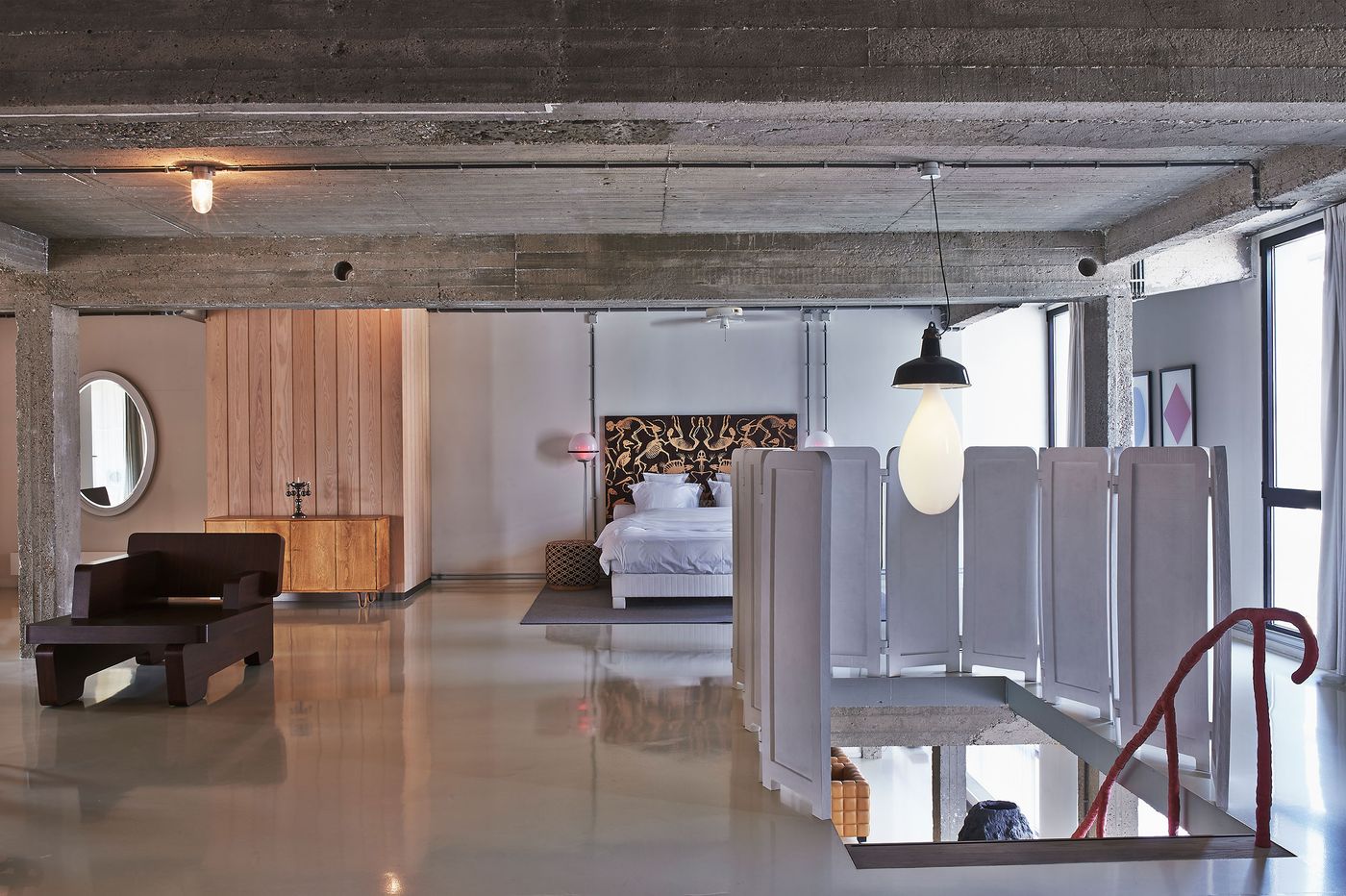
Dormitory. Long chair: Modular Furniture, Studio Job, 1999. Buffet: Pastoe DBo2 UMS, Cees Braakman, 1954. Candlestick Tin Ware, TE, Studio Job, 2007. Hanging Lamp Blup, Pieke Bergmans, 2009. Screen: Paper Screen (special), Moooi, Studio Job, 2008. Bed: Perished, Treca de Paris, Studio Job, 2007. Bedside table / ottoman: Edward van Vliet, 2003. Wall lamp: Arteluce 237, Gino Sarfatti, 1960. Mirror: Moooi, paper Mirror (special), 2006. Handrail: Clay, Maarten Baas, 2010.
Serigraphs: Concetto Spaziale, Lucio Fontano, 1965. Photo by Dennis Brandsma.
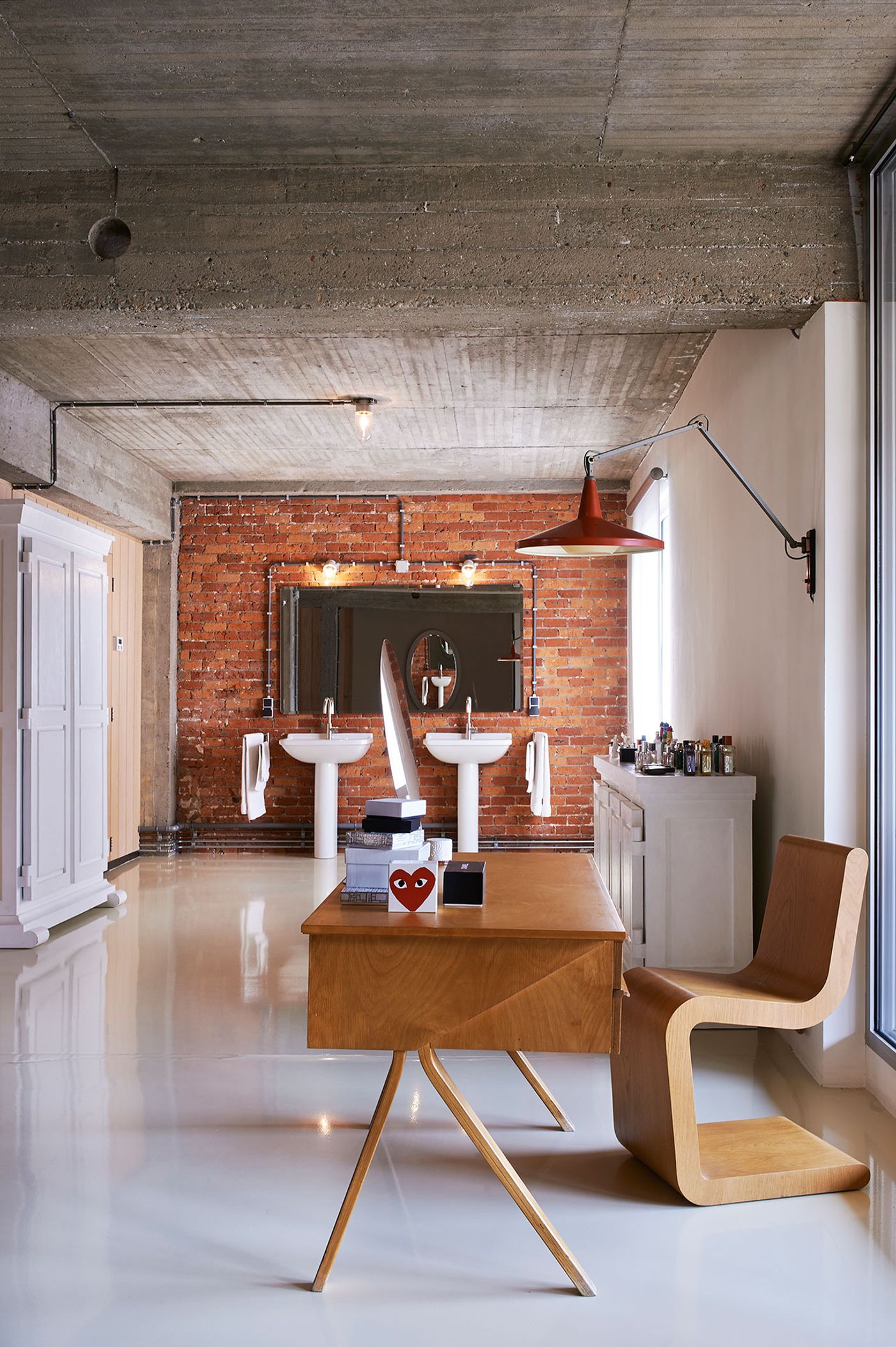
Bathroom. Cabinet: Paper Cupboard (special), Studio Job, 2005. Buffet: Buffet Paper (special), Studio Job, 2005. Wall lamp: Panama, Gispen, Wim Rietveld, 1955. Office: Pastoe, Cees Braakman, 1954. Chair: Curved Chair, Studio Job, 1998. Photo by Dennis Brandsma.
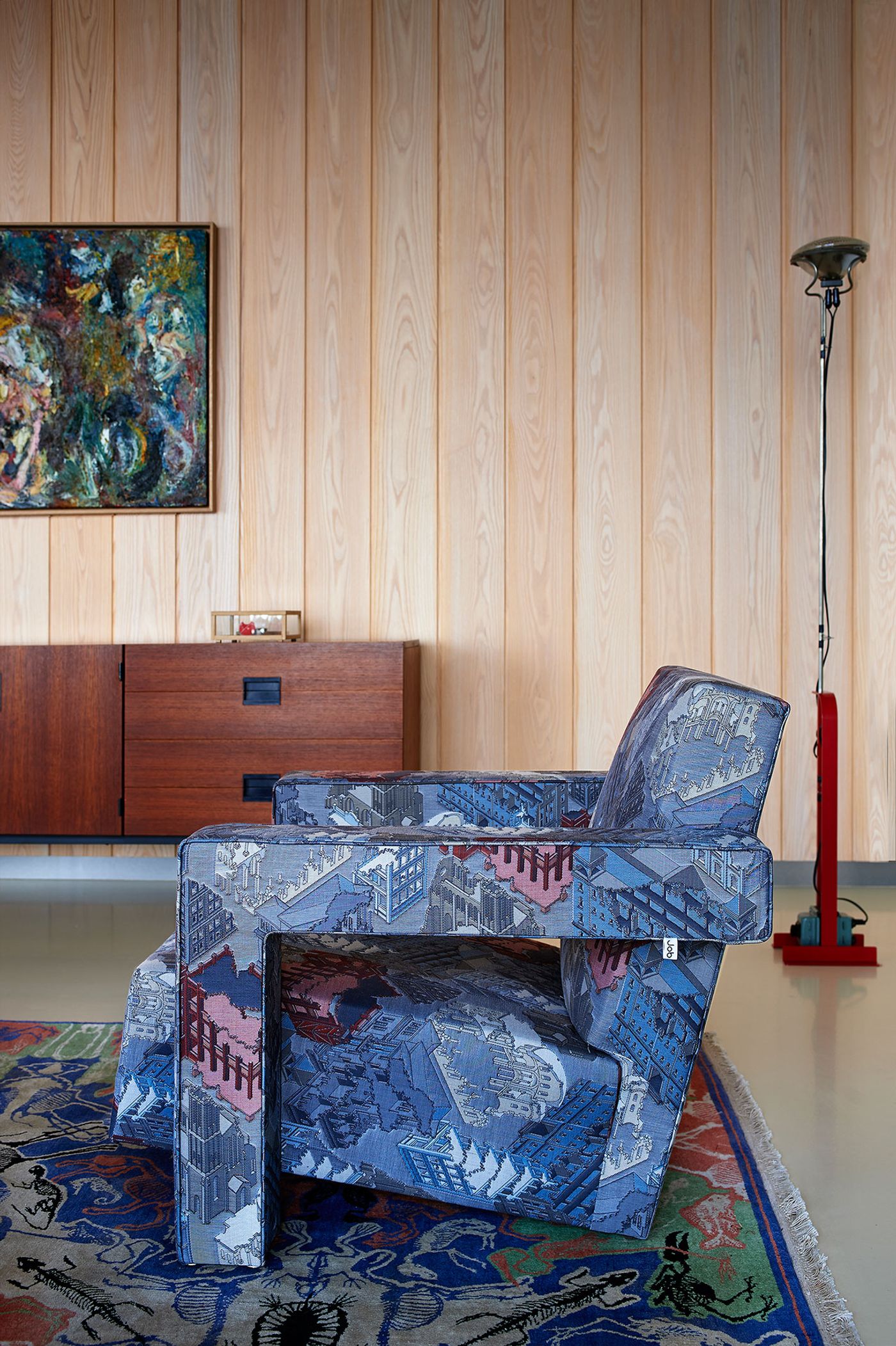
Utrecht Chair, Rietveld Ruins upholstered with fabric designed by Studio Job for Maharam. Perished Persian, Studio Job for Nodus. Credenza, Pastoe DU-03, Cees Braakman. Display box Memento, Knight & Clown. Marine painting, Constant Permeke. Floor Lamp, Achille / Ciacomo Castiglioni. Photo by Dennis Brandsma.